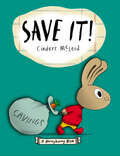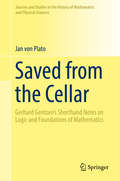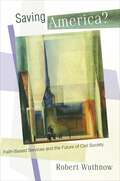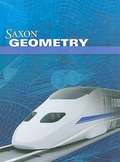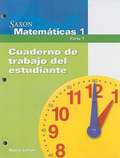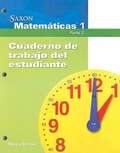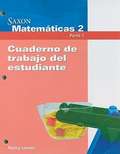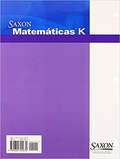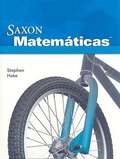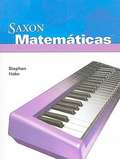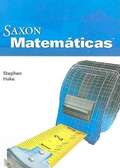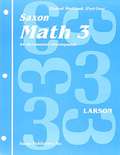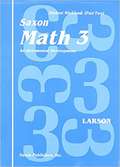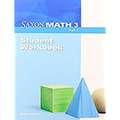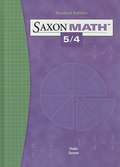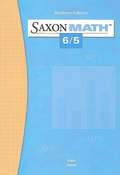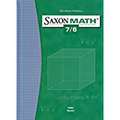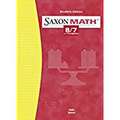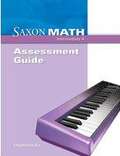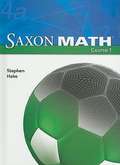- Table View
- List View
Save It! (A Moneybunny Book)
by Cinders McLeodA charming introduction to simple money concepts in which a little bunny learns about the power and satisfaction that come with saving money.Honey earns two carrots a week for taking care of her siblings. Her FIVE siblings who are so loud and bouncy, she wishes she had a place of her own to escape to for some peace and quiet. So what's a bunny to do? Get creative and figure out a savings plan--even if it means forgoing a treat or two. But saving is worth it because with a little patience and perseverance, Honey will be able to make her dream of having her owns space come true! This is the third book in the internationally acclaimed Moneybunnies Series--following Spend It! and Earn It!
Saved from the Cellar
by Jan Von PlatoGerhard Gentzen is best known for his development of the proof systems of natural deduction and sequent calculus, central in many areas of logic and computer science today. Another noteworthy achievement is his resolution of the embarrassing situation created by Gödel's incompleteness results, especially the second one about the unprovability of consistency of elementary arithmetic. After these successes, Gentzen dedicated the rest of his short life to the main problem of Hilbert's proof theory, the question of the consistency of analysis. He was arrested in the summer of 1945 with other professors of the German University of Prague and died soon afterward of starvation in a prison cell. Attempts at locating his lost manuscripts failed at the time, but several decades later, two slim folders of shorthand notes were found. In this volume, Jan von Plato gives an overview of Gentzen's life and scientific achievements, based on detailed archival and systematic studies, and essential for placing the translations of shorthand manuscripts that follow in the right setting. The materials in this book are singular in the way they show the birth and development of Gentzen's central ideas and results, sometimes in a well-developed form, and other times as flashes into the anatomy of the workings of a unique mind.
Saving America?: Faith-Based Services and the Future of Civil Society
by Robert WuthnowOn January 29, 2001, President George W. Bush signed an executive order creating the White House Office of Faith-Based and Community Initiatives. This action marked a key step toward institutionalizing an idea that emerged in the mid-1990s under the Clinton administration--the transfer of some social programs from government control to religious organizations. However, despite an increasingly vocal, ideologically charged national debate--a debate centered on such questions as: What are these organizations doing? How well are they doing it? Should they be supported with tax dollars?--solid answers have been few. In Saving America? Robert Wuthnow provides a wealth of up-to-date information whose absence, until now, has hindered the pursuit of answers. Assembling and analyzing new evidence from research he and others have conducted, he reveals what social support faith-based agencies are capable of providing. Among the many questions he addresses: Are congregations effective vehicles for providing broad-based social programs, or are they best at supporting their own members? How many local congregations have formal programs to assist needy families? How much money do such programs represent? How many specialized faith-based service agencies are there, and which are most effective? Are religious organizations promoting trust, love, and compassion? The answers that emerge demonstrate that American religion is helping needy families and that it is, more broadly, fostering civil society. Yet religion alone cannot save America from the broad problems it faces in providing social services to those who need them most. Elegantly written, Saving America? represents an authoritative and evenhanded benchmark of information for the current--and the coming--debate.
Saxon Matemáticas 1, Cuaderno de trabajo del estudiante, Parte 1(Texas)
by Nancy LarsonNIMAC-sourced textbook
Saxon Matemáticas 1, Cuaderno de trabajo del estudiante, Parte 2 (Texas)
by Nancy LarsonNIMAC-sourced textbook
Saxon Matemáticas 2, Cuaderno de trabajo del estudiante, Parte 1(Texas)
by Nancy LarsonNIMAC-sourced textbook
Saxon Matemáticas 3, Cuaderno de trabajo del estudiante, Parte 1
by Nancy LarsonNIMAC-sourced textbook
Saxon Matemáticas 3, Cuaderno de trabajo del estudiante, Parte 2
by Nancy LarsonNIMAC-sourced textbook
Saxon Matemáticas K, Cuaderno de trabajo del estudiante, Parte 1
by Nancy LarsonNIMAC-sourced textbook
Saxon Matemáticas K, Cuaderno de trabajo del estudiante, Parte 2
by Nancy LarsonNIMAC-sourced textbook
Saxon Math 3 - An Incremental Development - Student Workbook (Part One)
by Nancy LarsonSaxon Math 3 - An Incremental Development - Student Workbook (Part One)
Saxon Math 3 - An Incremental Development - Student Workbook (Part Two)
by Nancy LarsonSaxon Math 3 - An Incremental Development - Student Workbook (Part Two)
Saxon Math 3, Student Workbook, Part 1
by Nancy Larson Sharon Molster Orio Jeanne Honore MillerNIMAC-sourced textbook
Saxon Math 5/4 (3rd edition)
by Stephen Hake John SaxonAddition is the combining of two groups into one group. For addition example, when we count the dots on the top faces of a pair of dot cubes (dice), we are adding.
Saxon Math 6/5
by Stephen Hake John SaxonThis book is made up of daily lessons and investigations. Each lesson has four parts. The first part is a Warm-Up that includes practice of basic facts and mental math. The second part of the lesson introduces a new mathematical concept and presents examples that use the concept. Third one, the Lesson Practice helps solve problems involving the new concept. The final part is the Mixed Practice which reviews previously taught concepts and solving the problems set gives much benefit to students.
Saxon Math 7/6 (4th Edition)
by Stephen Hake John SaxonThis book was written to help you learn mathematics and to learn it well. For this to happen, you must use the book properly. As you work through the pages, you will see that similar problems are presented over and over again. Solving each problem day after day is the secret to success. This book is made up of daily lessons and investigations. Each lesson has four parts. The first part is a Warm-Up that includes practice of basic facts and mental math.
Saxon Math 8/7 with Pre-algebra
by Stephen Hake John SaxonThis book contains word problems that are often drawn from everyday experiences. It's also made up of daily lessons and investigations. Each lesson has four parts. The first part is a Warm-Up that includes practice of basic facts and mental math.
Saxon Math Course 1
by Stephan HakeSaxon Math Course 1 integrates and distributes traditional units, giving students time to learn and practice skills throughout the year, master content, and develop higher-order thinking.
